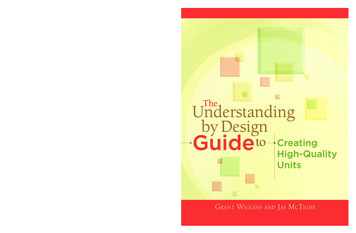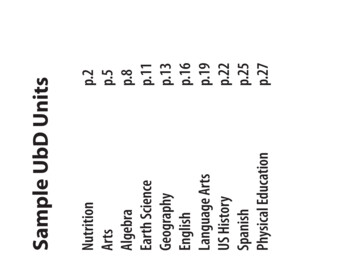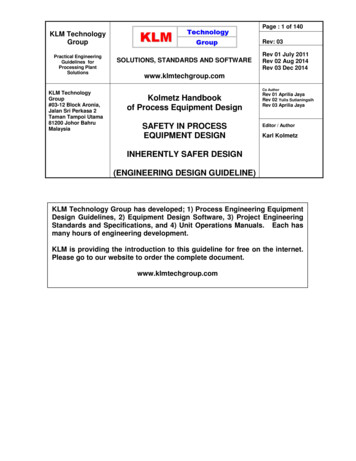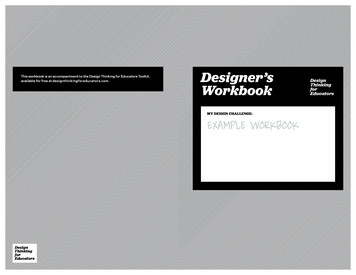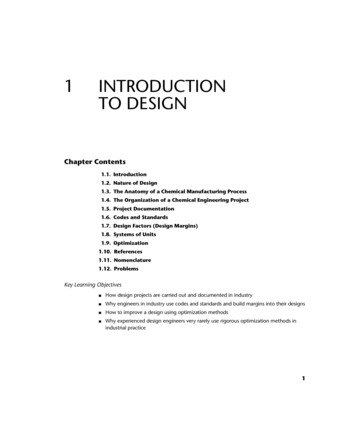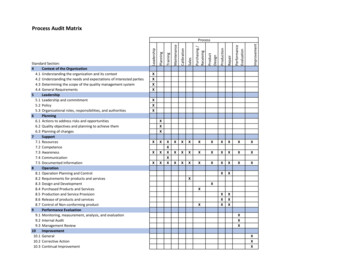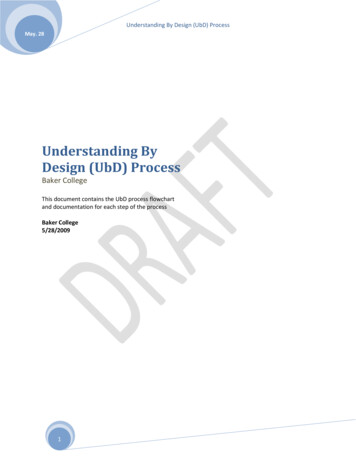
Transcription
Understanding By Design (UbD) ProcessMay. 28Understanding ByDesign (UbD) ProcessBaker CollegeThis document contains the UbD process flowchartand documentation for each step of the processBaker College5/28/20091
Understanding By Design (UbD) ProcessMay. 28Baker College Mission,Purposes, and Institutional Student Learning OutcomesBaker College MissionThe mission of Baker College is to provide quality higher education and training which enable graduatesto be successful throughout challenging and rewarding careers.Baker College PurposesPrepare students for competency in Business, Health, Human Services, and Technical careers intoday’s global economy.To provide general education which expands students’ horizons, develops strong communicationsskills, and encourages critical thinking.To provide students with practical experience and training in a chosen field of study.To encourage social and classroom related activities which promote both personal and professionalgrowth.To enhance students’ success through continuous assessment and improvement of teaching,learning, and institutional effectiveness.To assist graduates throughout their careers in securing employment and improving careeropportunities.To encourage graduates to continue their education and to lead effectively through service in aworld without boundaries.To offer graduate programs which provide students with advanced study, research, scholarly activity,and the opportunities for professional development.Baker College Institutional Student Learning Outcomes“Career-ready” knowledge and skills in the chosen career field.Behaviors and attitudes that promote success in the workplace as well as promote effective socialinteraction with diverse peoples across a range of situations.Information literacy which includes recognizing the need for information and identifying, locating,evaluating, and effectively using that information.Effective communication, including the use of technology, in various contexts and situations andwith a variety of audiences.Critical thinking skills including analysis and synthesis both within the career field and in moregeneral contexts.Effective problem-solving skills which are applicable to the field of study, the workplace, and otherlife situations.Broad-based knowledge, which includes an understanding of cultural, social, political, and globalissues.2
Understanding By Design (UbD) ProcessMay. 28Baker College UBD Process GraphicBaker College Mission, Purposes, andInstitutional Student LearningOutcomesProgramsCoursesInstructional UnitsLearning Experiences3
Understanding By Design (UbD) ProcessMay. 284
Understanding By Design (UbD) ProcessMay. 285
Understanding By Design (UbD) ProcessMay. 28Program Level DesignPre-Design WorkStep 1Collect currentdata regardingprogram1Collect all current and pertinent data regarding the new program. This should include but isn'tlimited to career data and data to support the need for the program. Include in this,information about the intended audience for the program and what level the programexists.certificate, associate, bachelor, masters, or doctorate. Use Baker Mission, Purposes,and Institutional Student Learning Outcomes.Step 2Identify who needsto be at the table2Suggested to include the following:Faculty for subject matter expertiseDean or Department HeadInstructional Designer (s) (must have)Career Services representative (people who know what students need for a career in thisprogram area)Advisory Board member(s) (this may help with the career information)System Curriculum DirectorProfessionals from fieldAssessment expertsNote taker to record work for documentation and historical purposesOthers?Step 3Schedule designmeeting3Send information to those identified to be at the table. Inform them of the meeting time andplace and provide current program data collected in step 1.6
Understanding By Design (UbD) ProcessMay. 28Program Level DesignStage One – Identify Desired ResultsStep 1Work through theStage 1 designquestions1Use Baker College UbD Design Template (taken from pg. 31 UbD Workbook)Use UbD design standards pg. 28Use Clarifying Content Priorities diagram pg. 71 of UbD and pg. 78 & 79 of UbD WorkbookUse Identifying Essential QuestionsAsk the following Stage 1 Questions at the program level.1.Established Goals: What are the long-term transfer goals? What relevant goals will this designaddress, includes standards, certifications, licensing requirements? In the end, students shouldbe able, on their own, to.2.Understandings: Students will understand that.these are overarching, enduringunderstandings.What are the Big Ideas? Big Ideas are defined as: (Wiggins & McTighe, 2006, Understanding byDesign, pg. 69) Broad and abstract Represented by one or two words Universal in application Timeless-carry through the ages Represented by different examples that share common attributes.What specific understandings about them are desired?Essential Questions: What are the essential questions to be continually explored? These areoverarching questions. Tip: We are looking for a “few good questions”. Essential questions aremeant to:7
Understanding By Design (UbD) ProcessMay. 28Program Level DesignStage One – Identify Desired ResultsCause genuine and relevant inquiry into the big ideas and core content.Provoke deep thought, lively discussion, sustained inquiry, and new understanding as well asmore questions.Require students to consider alternatives, weight evidence, support their ideas, and justify theiranswers.Stimulate vital, ongoing rethinking of big ideas, assumptions, prior lessons.Spark meaningful connections with prior learning and personal experiences.Naturally recur, creating opportunities for transfer to other situations and subjects.Students will know.What key knowledge and skills will students acquire?Students will be able to.What will students be able to do at the end of the program.We use the information from these two questions to write program outcomes in the next stepof process.These should all align with the Baker Mission, Purposes, and Institutional Student LearningOutcomes.Step 2Record Stage 1design questionanswers2Use the Baker College UbD Design Template taken from pg. 31 of UbD Workbook or UbDCurriculum Map for Stage 1 on pgs. 20 and 21 of UbD Workbook.8
Understanding By Design (UbD) ProcessMay. 28Program Level DesignStage One – Identify Desired ResultsStep 3 – Decision PointSatisfied with Stage1 design results?3All parties must agree with the responses to the Stage 1 design questions before moving to the next stepin the process. If there isn’t agreement, move back to Step 1 of Stage 1 and repeat process. Use DesignStandards document to assess Stage 1 against design standards.Step 4Write ProgramOutcomes4Students will be able to.What will students be able to do at the end of the program. This comes fromanswers to Stage 1 questions. Use Bloom’s Taxonomy action verbs. Write broad program outcomes atthis level. These should all align with the Baker Mission, Purposes, and Institutional Student LearningOutcomes.Step 5Map toInstitutional SLOs5Map program outcomes to Institutional SLOs. Make sure that program outcomes align with BakerMission, Purposes, and Institutional SLOs. Make adjustments as needed.Step 6 – Decision PointProgram outcomes andmapping ratified by allstakeholders?6All parties must agree with mapping to Institutional SLOs before moving to the next step in the process.If there isn’t agreement, move back to Step 4 of Stage 1 and re-work program outcomes. If there isagreement, move ahead in the process.9
Understanding By Design (UbD) ProcessMay. 28Program Level DesignStage Two – Determine Acceptable EvidenceStep 1Work throughStage 2 designquestions1Use Baker College Ubd Design Template taken from (pg. 31 UbD Workbook)Use UbD design standards pg. 28Assessment experts are highly involved hereAsk the following Stage 2 questions:What performances are indicative of understanding, transfer of learning and understanding of big ideas?This is at the program level so these answers may include ability for students to get a job, to getpromoted at their current job, to move into a career or to graduate level program. For programs thatrequire certification the performances may be related to preparation for passing the certification orobtaining a license. These should all align with the Baker Mission, Purposes, and Institutional StudentLearning Outcomes.What other evidence is required in light of the Stage 1 desired results? (Program Outcomes)What criteria and indicators will be used to assess against the goals? (How are you going to know thatstudents are successful at achieving the program outcomes?)Step 2Record Stage 2design questionanswers2Use Baker College UbD Design Template taken from pg. 31 of UbD WorkbookStep 3Designassessment plan3The assessment plan at the program level provides general ideas of assessment types that will provideevidence of successful completion of the program. The tools are designed and developed later based onthis information.10
Understanding By Design (UbD) ProcessMay. 28Program Level DesignStage Two – Determine Acceptable EvidenceAssessments should include longitudinal assessments for transfer and assessments that measurestudent success at the end of the program. See pg. 92 of Schooling by Design. Assessments should alsobe formative at points during the program to assess student learning and progress toward programoutcomes.Step 4Map assessmentplan to programoutcomes4This will show how the assessment plan aligns to each of the program outcomes.Step 5 – Decision PointAssessment designplan ratified by allstakeholders?5All parties must agree with answers to the Stage 2 questions before moving to the next step in theprocess. If there isn’t agreement, move back to Step 1 of Stage 2. If there is agreement, move ahead tothe next step.11
Understanding By Design (UbD) ProcessMay. 28Program Level DesignStage Three – Planning Learning ExperiencesStep 1Translate Stage1& 2 answers intotopics1Based on Stage 1 answers and stage 2 assessments, what overarching areas (sometimes called topicareas) do we need to address in the program? This information will lead to the identification of courses,course SLOs and enabling objectives. Align these with program outcomes.Step 2 – Decision PointSatisfied with topicareas?2All parties must agree with answers to the topic areas before moving to the next step in the process. Ifthere isn’t agreement, move back to Step 1 of Stage 3. If there is agreement, move ahead to the nextstep.Step 3Identify courses toalign with programoutcomes3Take the topics identified in the previous step and identify course areas that will cover these topics.SLOSs for the courses are not created at this point as they must go through the stage 1 at the courselevel.Step 4Identify courses &sequenceIdentify new course and existing course to be used and sequence the courses in the order they will betaken in the program. This includes the identification of prerequisite courses. This is important becausecreating the course SLOs requires identifying the courses to be taken before and after each course. Atthis point it may be possible to determine the credit hours for the course, and, if needed, the number ofhours of lecture versus lab time.12
Understanding By Design (UbD) ProcessMay. 28Course Level DesignPre-Design WorkStep 1Identify course fordesign1Step 2Identify courses insequence2This includes all prerequisite courses and the next courses in line.Step 3Collect currentdata regardingcourse3Data can include career data from potential employers, Advisory Boards, if it is an existing course anydata collected regarding student and faculty satisfaction, direct measure data, data about the courseitself such as credit hours and labs, program data, data from faculty who teach or have taught thecourse (best practices, what worked and didn’t work). Collect information on standards that must bemet for certifications, licensing, etc. Use program information from earlier in the process to identifyintended audience. These should all align with the Baker Mission, Purposes, and Institutional StudentLearning Outcomes.Step 4Identify who needsto be at the table4The process changes here. We don't need all the individuals at the table that were present before. Aslong as we have collected the data from step 3, the following are needed:Faculty for subject matter expertiseInstructional Designer (s) (must have)13
Understanding By Design (UbD) ProcessMay. 28Course Level DesignPre-Design WorkStep 5Schedule designmeeting5Send information to those identified to be at the table. Inform them of the meeting time andplace and provide current course and program data collected in step 1.14
Understanding By Design (UbD) ProcessMay. 28Course Level DesignStage One – Identify Desired ResultsStep 1Work through theStage 1 designquestions1Use the Baker College UbD Design Template taken from pg. 31 UbD WorkbookUse UbD design standards pg. 28Use Clarifying Content Priorities diagram pg. 71 of UbD and pg. 78 & 79 of UbD WorkbookAsk the following Stage 1 Questions at the course level.5.Established Goals: What are the long-term transfer goals? What relevant goals will this design address,includes standards, certifications, licensing requirements? In the end, students should be able, on theirown, to.6.Understandings: Students will understand that.these are overarching, enduring understandings.What are the Big Ideas? Big Ideas are defined as: (Wiggins & McTighe, 2006, Understanding by Design,pg. 69) Broad and abstract Represented by one or two words Universal in application Timeless-carry through the ages Represented by different examples that share common attributes.What specific understandings about them are desired?Essential Questions: What provocative questions will foster inquiry, understanding and transfer oflearning? These are overarching questions. Tip: We are looking for a “few good questions”. Essentialquestions are meant to:Cause genuine and relevant inquiry into the big ideas and core content.Provoke deep thought, lively discussion, sustained inquiry, and new understanding as well as morequestions.15
Understanding By Design (UbD) ProcessMay. 28Course Level DesignStage One – Identify Desired ResultsRequire students to consider alternatives, weight evidence, support their ideas, and justify their answers.Stimulate vital, ongoing rethinking of big ideas, assumptions, prior lessons.Spark meaningful connections with prior learning and personal experiences.Naturally recur, creating opportunities for transfer to other situations and subjects.Students will know.What key knowledge and skills will students acquire? What will students be able todo at the end of the course? This information will be used to write the SLOs and enabling objectives inStep 4.These should all align with the Baker Mission, Purposes, and Institutional Student Learning OutcomesStep 2Record Stage 1design questionanswers2Use the Baker College UbD Design Template taken from pg. 31 UbD Workbook.Step 3 - Decision PointSatisfied with Stage1 design answers?3All parties must agree with the responses to the Stage 1 design questions before moving to the next stepin the process. If there isn’t agreement, move back to Step 1 of Stage 1 and repeat process.Step 4Write courseSLOs andenablingobjectives4Students will be able to.What will students be able to do at the end of the course? This comes fromanswers to Stage 1 questions. Use Bloom’s Taxonomy action verbs. Write broad student learningoutcomes at this level. Write specific enabling objectives for each SLO using Bloom’s Taxonomy actionverbs, conditions, and criterion to meet Quality Matters standards and guide students' understanding ofwhat learning will take place. Get these into a rough format. For online and hybrid, incorporate QualityMatters standards for16
Understanding By Design (UbD) ProcessMay. 28Course Level DesignStage One – Identify Desired Resultsoutcomes and objectives. Instructional Designers will write appropriate SLOs and enabling objectivesand align to Quality Matters.Step 5 - Decision PointDo SLOs & enablingobjectives align withprogram outcomes?5All parties must agree that the SLOs and enabling objectives align with the program outcomes beforemoving to the next step in the process. If there isn’t agreement, move back to Step 4 of Stage 1 andrepeat process. If everyone agrees, move to the next step in the process. Instructional Designers willcomplete the mapping.Step 6Map SLOs &enablingobjectives fromStage 1 work toRigor andRelevance6In this step, map the SLOs and enabling objectives to Blooms Taxonomy and levels of authenticapplication USING RIGOR AND RELEVANCE. This will provide us a map that we can use to align the SLOsand enabling objectives to appropriate assessments, instructional strategies and learning activitiesbased on research. The Rigor and Relevance framework mapping tool can be obtained from BakerOnline CDT. Instructional Designers will complete the mapping.Step 7Are the SLOs &enabling objectivesaligned to Rigor andRelevance?7All parties must agree Rigor and Relevance mapping before moving to the next step in the process. Ifthere isn’t agreement, move back to Step 6 or 7 of Stage 1 and repeat process. If everyone agrees, moveto the next step in the process. Instructional Designers will review mapping for approval.17
Understanding By Design (UbD) ProcessMay. 28Course Level DesignStage One – Identify Desired ResultsStep 8 – Decision PointSLOs ratified by allstakeholders?8All stakeholders must agree with SLOs before moving forward in the process.18
Understanding By Design (UbD) ProcessMay. 28Course Level DesignStage Two – Determine Acceptable EvidenceStep 1Identify who needsto be at the table.1Identify who needs to be at the table for this part of the process. This is primarily the work of theinstructional designers.Content experts and assessment experts should be used as needed for consultation, but theinstructional designers have the expertise to design appropriate assessments at the course level.Step 2Complete SLO,RecommendedStrategies part ofCDT2The Course Design Template (CDT) is used by Baker Online and is the "blue print" for thecourse". This is the work of the Instructional Designers.Step 3Work throughStage 2 designquestions3Use the Baker College UbD Design Template taken from page 31 of the UbD WorkbookUse UbD design standards pg. 2819
Understanding By Design (UbD) ProcessMay. 28Course Level DesignStage Two – Determine Acceptable EvidenceAsk the following Stage 2 questions:“When we speak of evidence of desired results, we are referring to evidence gathered through a varietyof formal and informal assessments during a unit of study or a course. We are not alluding only to endof-teaching tests or culminating tasks. Rather, the collected evidence we seek may well includetraditional quizzes and tests, performance tasks and projects, observations and dialogues, as well asstudents’ self-assessments gathered over time.” (Wiggins & McTighe, 2006, Understanding by Design, pg.19) Based on Rigor and Relevance mapping, what are appropriate types of assessments for the quadrantswhere SLOs and enabling objectives reside? Refer to SLO, recommended instructional strategies andassessments documents. What performances are indicative of understanding, transfer of learning and understanding of contentvia big ideas? Use 6 facets of understanding to guide assessments.1.Understanding as Explanation2.Understanding as Interpretation3.Understanding as Application4.Understanding as seeing things in Perspective5.Understanding as having Empathy6.Understanding as Reflective Self-KnowledgeUse course level enabling objectives from Stage 1. What other evidence is required in light of the Stage 1 desired results? What formative assessments will be used and what feedback will be given? What criteria and indicators will be used to assess student work against the goals? Use Rigor andRelevance for appropriate assessment types. Include self-assessments and reflections. For online and hybrid incorporate Quality Matters standards for assessments. Assessments must align to SLOs and enabling objectives from Stage 1.20
Understanding By Design (UbD) ProcessMay. 28Course Level DesignStage Two – Determine Acceptable EvidenceStep 4Record Stage 2design questionanswers4Use the Baker College UbD Design Template taken from pg. 31 UbD Workbook. This includes recordingall stage 2 assessment types.Step 5 – Decision PointSatisfied with Stage2 answers?5All parties must agree with the responses to the Stage 2 design questions before moving to the next stepin the process. If there isn’t agreement, move back to Step 2 of Stage 2 and repeat process. If there isagreement, move on to the next step in the process.Step 6Designassessment plan6Assessments should be formative at points during the course to assess student learning and progresstoward student learning outcomes and summative at the end of the course. Use the information fromstep 2 to design detailed assessments. Add this information to the UbD Design template.21
Understanding By Design (UbD) ProcessMay. 28Course Level DesignStage Three – Planning Learning ExperiencesStep 1Identify who needsto be at the table.1This is the work of the instructional designers. This is their area of expertise. Content experts andassessment experts should be used as needed for consultation. Instructional designers have theexpertise to design the course learning experiences and assessment tools.Step 2Work throughStage 3 designquestions2Use the Baker College UbD Design Template taken from pg. 31 UbD Workbook.Use UbD design standards pg. 28Ask the following Stage 3 questions: What do students need to acquire in order to be successful? What enabling knowledge (facts, concepts,principles) and skills (processes, procedures, strategies) will students need in order to performeffectively and achieve desired results? What inquiries and meaning making must they actively be made to engage in?What activities will equip students with the needed knowledge and skills? What transfer must they practice and get feedback on?What will need to be taught and coached, and how should it best be taught, in light of performancegoals (stage 2)? Use the Rigor and Relevance framework from Step 6 of Stage 1 for appropriate instructional strategiesand learning experiences. What sequence is optimal for engagement and success? For online and hybrid, use Quality Matters standards for engagement, instructional materials, andmedia. How will the work be differentiated without sacrificing SLOs? - this helps to optimize success of all.22
Understanding By Design (UbD) ProcessMay. 28Course Level DesignStage Three – Planning Learning ExperiencesStep 3 – Decision PointSatisfied with Stage3 answers?3All parties must agree with the responses to the Stage 3 design questions before moving to the next stepin the process. If there isn’t agreement, move back to Step 2 of Stage 3 and repeat process. If there isagreement, move on to the next step in the process.Step 4Design learningexperiences& assessments4Use the Learning Principles on page 113 - 121 of Schooling by Design as a guide. Use the Baker UbDTemplate.Use, How People Learn as a guide.Use the WHERETO model W - Ensure students understand where the learning experiences are headed and why.H- Hook students in the beginning and hold their attention.E - Equip students with necessary experiences, tools, knowledge, and know how to meet SLOs.R- Provide students with numerous opportunities to rethink big ideas, reflect on progress, and revisetheir work.E - Build in opportunities for students to evaluate process and self-assess.T - Tailor the course to reflect individual talents, interests, styles, and needs.O - Organize to optimize deep understanding as opposed to superficial coverage.Use six facets of understanding:1.Understanding as Explanation2.Understanding as Interpretation3.Understanding as Application23
Understanding By Design (UbD) ProcessMay. 28Course Level DesignStage Three – Planning Learning ExperiencesStep 4 – continuedDesign learningexperiences& assessments44. Understanding as seeing things in Perspective5.Understanding as having Empathy6.Understanding as Reflective Self-Knowledge Model learning experiences so they are in-depth not superficial. Plan for Uncoverage vs. Coverage Use problem-based learning, authentic learning experiences, ill-structured problems, questioning,critical thinking, and high levels of application to ensure transfer. Identify media needs. Align learning experiences to Quality Matters standards. Align learning experiences to Rigor and Relevance.Complete any design of assessments from the assessment plan in Stage 2. Consider designing multiple assessments and learning experiences that all align to the SLOs so thatinstructors have a choice.Add this information to Stage 3 of the UbD template.Step 5Identifyinstructionalresources andmaterials tosupport learningexperiences5Identify resources to introduce learning, resources to help students practice learning and get feedback,and resources to support assessments. Include media to support learning experiences and assessments.Use assessment information from Stage 2, Step 6. Align all resources for online and hybrid courses toQuality Matters Standards. Use the Baker UbD Template.24
Understanding By Design (UbD) ProcessMay. 28Course Level DesignStage Three – Planning Learning ExperiencesStep 6Map assessmentsfrom Stage 2 andlearningexperiences fromStage 3 to SLOmatrix.6Using the SLOs and enabling objectives from Stage 1, map assessments and learning experiences fromstage 3 to the SLO matrix portion of the Course Design Template (CDT). Include SLOs, enablingobjectives, sequence, assessments, instructional strategies, learning experiences, and media. Look foralignment of all assessments and learning experiences to the SLOs and enabling objectives. This iswhere sequencing of the learning experiences takes place as the matrix is set-up on a weekly basis. SeeSLO matrix from Course Design Template completed in Stage 2, step 2.Consult as needed with subject matter expert.Align learning experiences and assessments to Quality Matters standards.Align with Rigor and Relevance.Step 7 – Decision PointDo assessments andlearning experiences alignwith SLOs and enablingobjectives?7All parties (Instructional Designers & Subject Experts) review the SLO matrix from the CDT and agree onalignment of critical course elements, assessments, learning experiences, and technology to the SLOsand enabling objectives. Subject matter experts review the completed SLO matrix and give feedback. Allmust agree there is alignment to SLOs and enabling objectives before moving to the next step in theprocess. All stakeholders will approve.Step 8Develop coursedocuments foronline, hybrid, andf2f course8These include documents such as the syllabus, detailed course layout using SLO matrix, lesson plans,resources, instructional materials, assessment tools (rubrics), and media. This information will come25
Understanding By Design (UbD) ProcessMay. 28Course Level DesignStage Three – Planning Learning Experiencesfrom the SLO matrix (CDT) and the UbD design document. The information should be detailed enoughfor a faculty member to teach the course from this document.Step 9Build Blackboardcourse shells9All courses will have a master Blackboard course shell Build the online master course in Blackboard, which will contain all materials from Step 8. This is theprimary course from which the hybrid and on-ground courses will be built. Build the master online hybrid course in Blackboard using materials from the online Blackboard course. Build the Blackboard course for the on-ground face-to-face course. This Blackboard course will containlearning materials, media, and assessments, all materials from Step 8 and the online course.Use Baker Online Course Design checklist and Quality Matters rubric to guide the course build inBlackboard.Review completed courses against Quality Matters standards for online and hybrid courses.Step 10Launch course(s)10Preferably, this would be a small pilot, but our course model generally doesn’t allow this.Step 11Collect andanalyze data11This should include the following data:Level 1 (reaction) data from students regarding the courseLevel 1 (reaction) data from faculty regarding the courseLevel 2 (learning) assessment and evaluation data regarding student learning26
Understanding By Design (UbD) ProcessMay. 28Course Level DesignStage Three – Planning Learning ExperiencesLevel 3 (transfer) ideally, we would collect data on how students are using the knowledge and skills intheir work or furthering their education. See pg. 92 of Schooling by Design for longitudinal rubric andassessments.Analyze all data to see what it tells us and use it to continually improve the courses.Also collect and analyze process data:Level 1 (reaction) data from all participants in the UbD process. Analyze the data to see what it tells usand use it to continually improve the UbD process.Step 12Revise coursebased on data, ifnecessary.1227
May 28, 2009 · Understanding By Design (UbD) Process May. 28 7 Program Level Design Stage One – Identify Desired Results Step 1 Work through the S tage 1 design q uestions 1 Use Baker College UbD Design Template (taken from pg. 31 UbD Workbook) Use UbD design standards pg. 28 Use Clarifying Content
